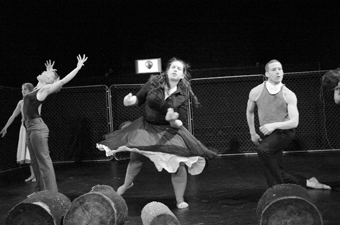Choreographers Alethea Adsitt and Alexandra Beller both explore theater themes in dance at East Village’s Connelly
By GUS SOLOMONS JR.
The Connelly Theater in the East Village isn’t on the regular circuit of dance venues; it’s a cozy, intimate theater with a narrow stage, but perfect for the theater dances of two powerfully individual choreographic voices that spoke loudly and clearly in a shared concert there this past weekend.
Alethea Adsitt, recently transplanted from Seattle, moved with fresh openness, doing her challenging, physically luscious dancing. She inflected sliding falls, shoulder flips and complicated spinning patterns with small, unexpected, personal tics that reinforced the specific personalities of her stellar dancers.
In “Blink: The Indelible Blue Wall Coda,” Adsitt reflects on the frenetic urbanity of New York life. As dancers stood on red diamond-shaped marks on the stage floor, video by Dorian Nuskind-Oder projected city traffic speeding by. The live dancers walked randomly, crowded together, bumped, tussled and lifted each other, while Adsitt watched from aloft, behind the projection scrim.
Group passages of brusque action separated solos and duets. Dancers surged toward the audience repeatedly; each time a different one fell down, unable to maintain the hectic pace. In a duet, strong, acrobatic Jill Frere, like a playful bulldog, hefted lanky Samson Baker as easily as he lifted her. Courtney Drasner and Richard Ayers did a fast-paced, tongue-in-cheeky cha cha.
Paige silently read one of the crumpled papers that Baker dumped over her head, then spoke, breaking the kinetic spell; her strong movement needing no text. Adsitt’s deftly executed solo introduced motifs done by others in various sections. “Blink” demonstrated Adsitt’s solid grasp of composition, as well as a strong sense of theater.
George Graham’s original music blended with selections by Paul Duncan, Mikel Laboa and the Bavarian Fruit Band. The video, which recurred throughout the 35-minute piece, switched to pedestrians, racing back and forth, and then vehicles and people, freezing appropriately to avoid distracting from the live action.
Alexandra Beller made her mark as a member of the Bill T Jones/Arnie Zane troupe, affirming a place for queen-sized dancers on the concert stage. Her own work blends theater and movement, and “You Are Here,” choreographed in collaboration with a dynamite cast, hit home with astute choices and intense performances.
Chain-link fencing ringed three sides of the stage, limiting the ambit of five occupants. A teal-blue balloon in a glowing white niche in the back wall hovered above the fence; another blue balloon bobs tauntingly, just beyond the fence downstage. Beller, Eric Bradley, Megan Brunsvold and Lillian Stillwell stood at the rear fence, two on each side, looking out; Toni Melaas reclining, sleeping, downstage center, in a cluster of tree stumps.
Beller’s opening solo introduced us to a woman, restless as a caged lion, her foot vibrating, then her outstretched hand. She perched on one foot, shaking her head, tumbled and rolled on the ground; she bumped against the fence, then her body echoed the jolt.
Versatile Bradley doubles as costume designer, dressing Beller in a flowing brown skirt; he put himself, Stillwell and Brunsvold in gray and black. Melaas—who acted a bubbly hostess—wore a bright green jacket and orange-trimmed white skirt. She spouted a random list of don’ts from a tome: “Don’t kick the wings. Don’t squeeze your ass cheeks. Don’t fuck your children!” A deafening phone ring stopped only when Beller clawed through the fencing, grabbed the balloon and let Stillwell pop it. Brunsvold tap-danced barefoot, incongruously gleeful.
Bradley and Stillwell, both tall and lean, ran hand in hand in unison to the rhythm of music played live by Robert Moss on assorted instruments, while his recorded score played subtly in the background. Beller and her dancers fashioned a fascinating, deeply haunting, claustrophobic world of frustrated desires, an existential hell and a work that deserves longer than a weekend.
Mandy Ringger’s strikingly imaginative lighting, achieved with minimal equipment, enlivened both pieces.
gaycitynews.com

































